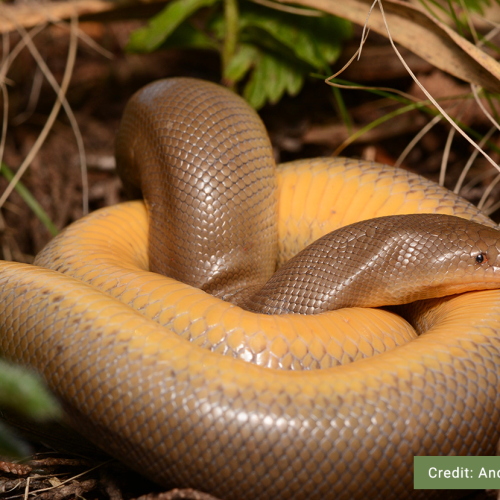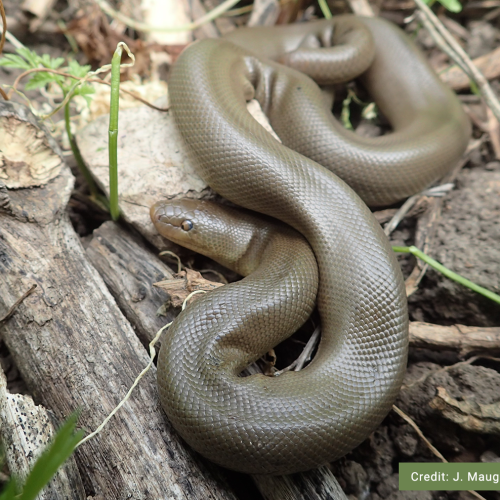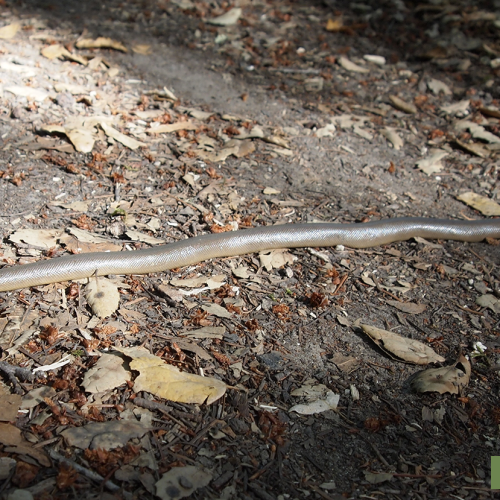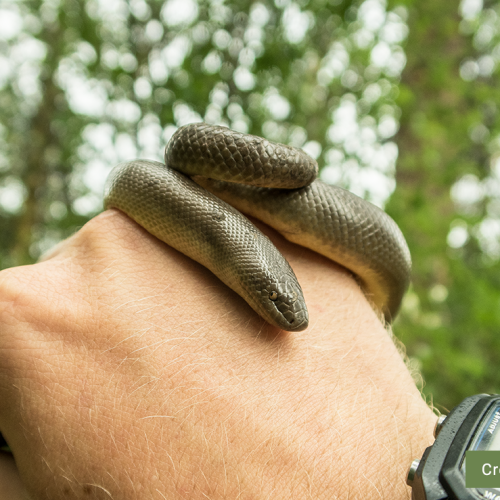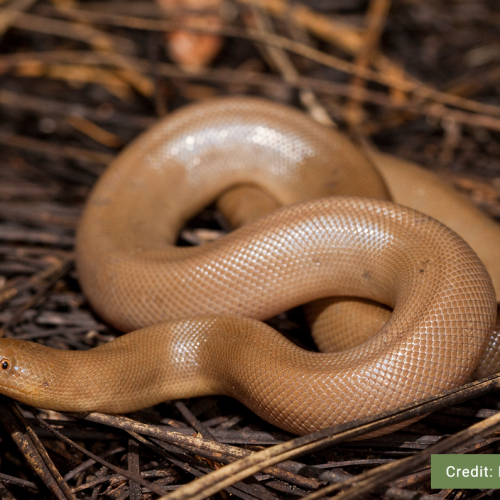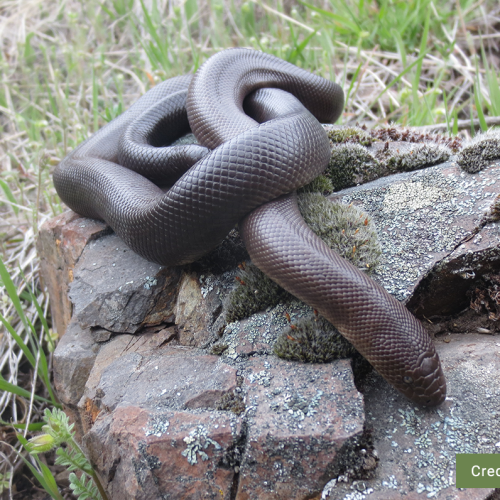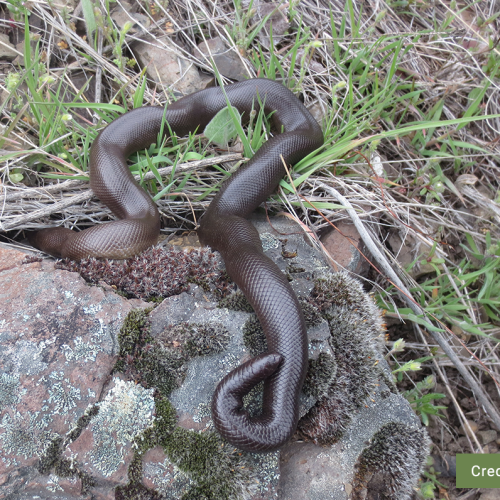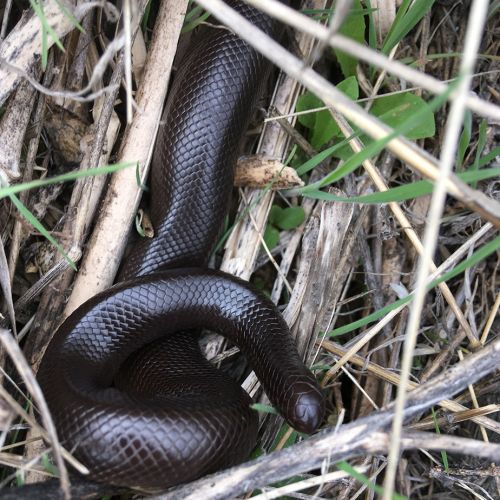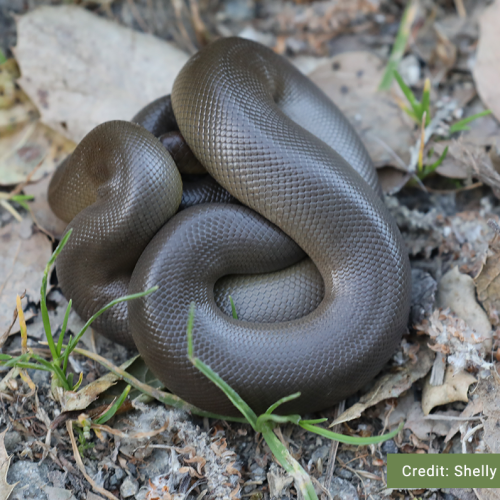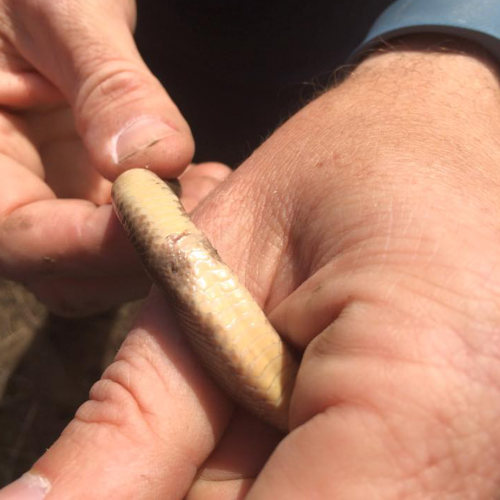Credit: Jade Spruyt
Northern Rubber Boa
Charina bottae
Description
The Northern Rubber Boa is a distinct, small, thick-bodied snake that is almost always less than 70 cm long. They have loose skin with very small, smooth scales that give it a rubbery appearance. Rubber Boas are characterized by their uniform colour, ‘rubbery’-looking skin, and their blunt tails that resemble their heads. In fact, they are also known as the “Two Headed Snake” as it is solid-coloured, making it very difficult to tell the head from the tail unless very close. The head is blunt like the tail and the eyes are very small with elliptical pupils. They are typically dark olive green or brown with pale yellow-orange bellies. Juvenile Rubber Boas are very small and more pink/orange in colour, very closely resembling a large earthworm. Male Rubber Boas have vestigial limbs on either side of the cloacaDefinition:The common cavity in which the intestinal, urinary, and reproductive canals open in birds, reptiles, amphibians, many fishes, and certain mammals. that appear as small dark spurs.
Listen to the Indigenous words for “snake” here!
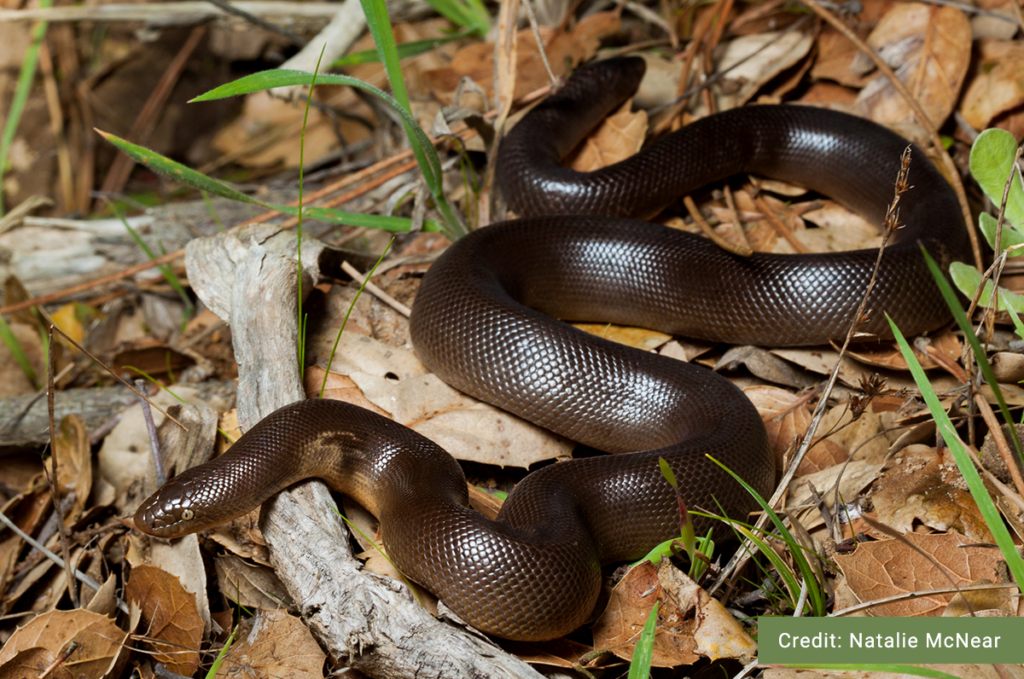
Similar Species
There are two other uniformly coloured snakes in British Columbia that could be confused with the Northern Rubber Boa from afar, though from up close the difference is obvious. The Western Yellow-bellied Racer and the Common Sharp-tailed Snake are both solid-colored snakes, although Yellow-bellied Racers are larger than Rubber Boas and both species have long, pointed tails.

Northern Rubber Boa
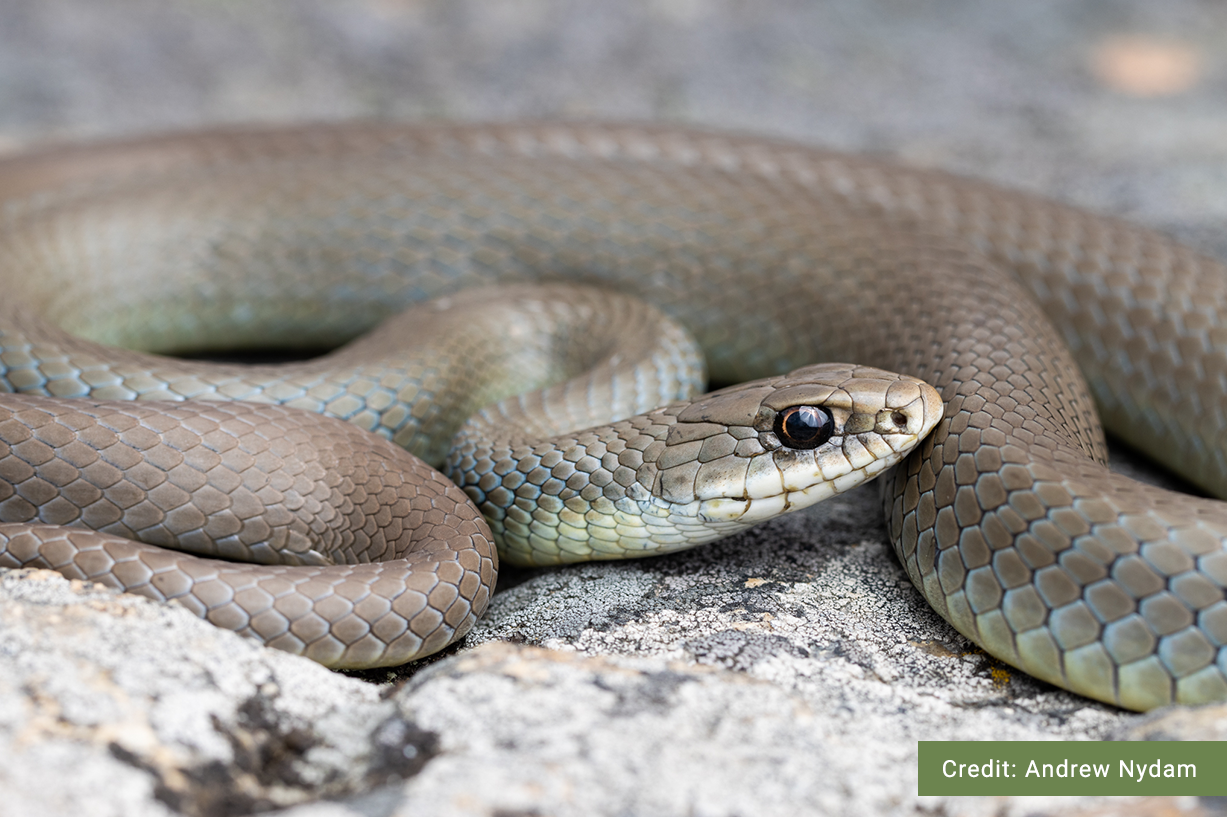
Western Yellow-bellied Racer

Common Sharp-tailed Snake
Distribution
Habitat
In British Columbia, the Northern Rubber Boa hibernatesDefinition:Term to describe a period of dormancy in animals, usually as a response to low external temperatures during which most metabolic processes are slowed, including respiration and thermoregulations. throughout the winter in rocky crevices, root hollows, or old mammal burrows that dip below the frost line. When temperatures are warm enough in the spring, they emerge from overwintering dens but remain concealed for much of this emergence period, which can last several weeks. Once daytime temperatures are warm enough (typically above 20 degrees Celsius), they will disperse into their summer range. Rubber Boas can be found in a variety of habitats including woodlands, grasslands, coniferous forests, dry pine forests, juniper woods, and riparian areas. Although they are able to occupy a variety of habitats, they generally avoid hot, dry areas and prefer more humid and mountainous areas. Within their habitats, cover objects and burrows are important microhabitat features and they spend most of their lives either concealed or underground. During the spring Rubber Boas are active during the day to avoid the cool nights, but in the summer, they are primarily nocturnalDefinition:Active during the day. to avoid the arid days.

Reproduction
orthern Rubber Boas mate in the spring very shortly after emergence from their overwintering dens. Rubber Boas are ovoviviparousDefinition:A reproductive strategy where eggs develop and hatch inside the mother’s body, with the young feeding off the yolk sac until shortly after birth., giving birth to 2-8 live young in late summer or early autumn. Females generally mate every other year but may be limited to every 3 or 4 years in some instances, especially if temperatures are low which do not allow embryos to develop. Rubber Boas reach sexual maturity after 3-5 years, and have a long lifespan of up to 30 years.

Diet
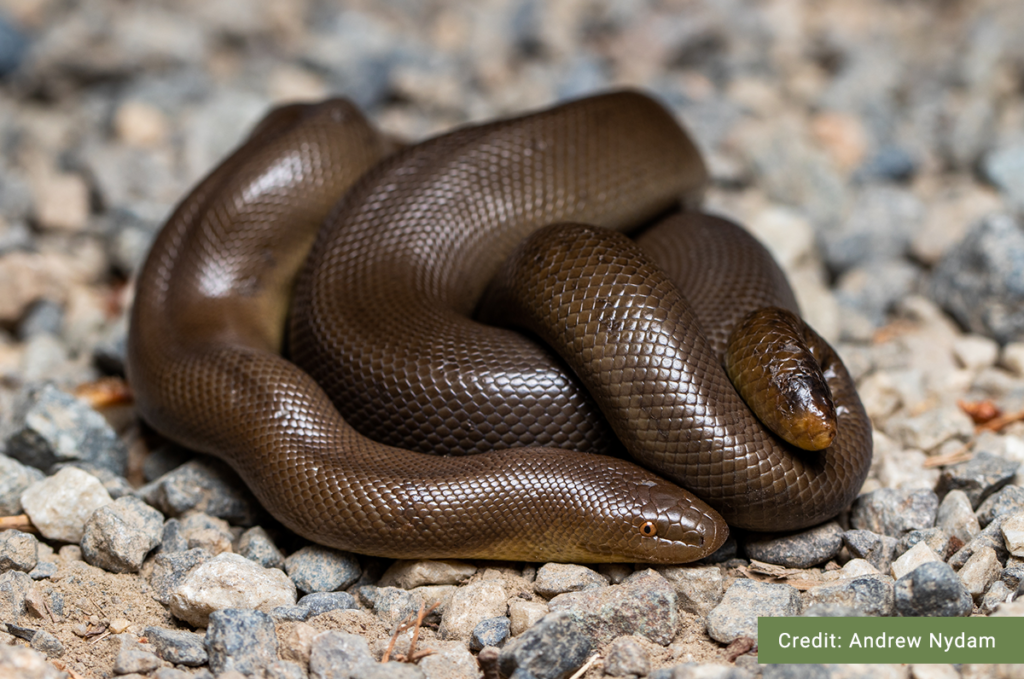
Conservation Status
Global: G5 (2016)
COSEWIC: SC
SARA:1-SC (2005)
Provincial: S4 (2018)
BC List: Yellow
Learn more about conservation status rankings here
Threats
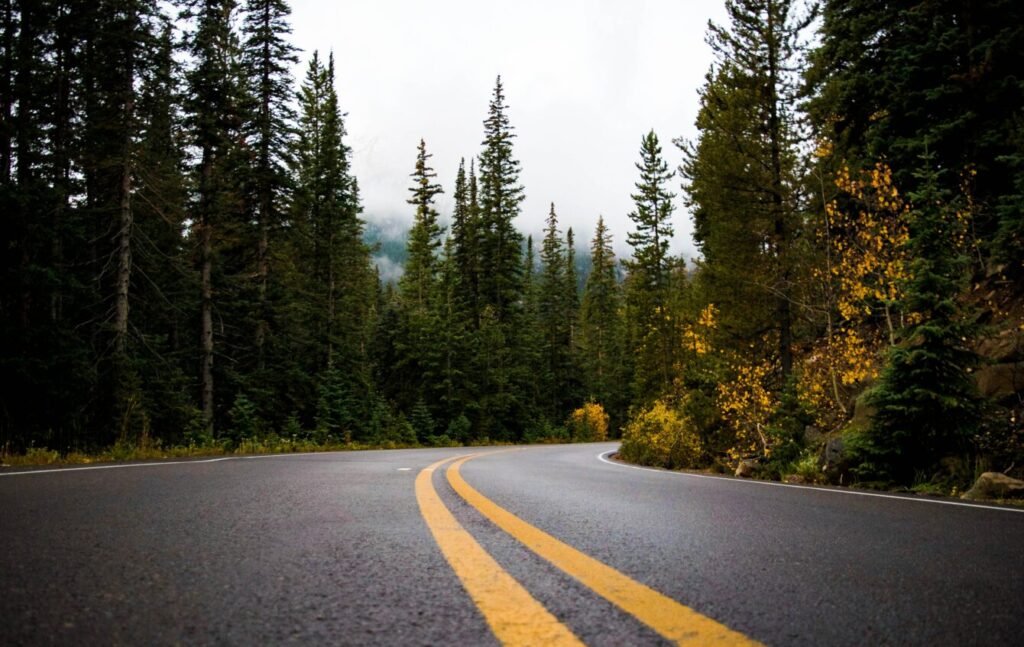
Did You Know?
Fact #1
Fact #2
Fact #3
Species Account Author: Marcus Atkins
B.C. Conservation Data Centre. 2011. Species Summary: Charina bottae. B.C. Minist. of Environment. Available: https://a100.gov.bc.ca/pub/eswp/ (accessed Jun 15, 2021).
B.C. Conservation Data Centre. 2018. Conservation Status Report: Charina bottae. B.C. Minist. of Environment. Available: https://a100.gov.bc.ca/pub/eswp/ (accessed Jun 15, 2021).
B.C. Conservation Data Centre. 2021. BC Species and Ecosystems Explorer. B.C. Minist. of Environ. Victoria, B.C. Available: https://a100.gov.bc.ca/pub/eswp/ (accessed Jun 15, 2021).
B.C. Ministry of Environment. 2015. Management plan for the Northern Rubber Boa (Charina bottae) in British Columbia. Prepared for the B.C. Ministry of Environment, Victoria, BC. 24 pp.
COSEWIC. 2016c. COSEWIC assessment and status report on the Northern Rubber Boa Charina bottae in Canada. Committee on the Status of Endangered Wildlife in Canada. Ottawa. xiii + 38 pp.
Environment and Climate Change Canada. 2017g. Management Plan for the Northern Rubber Boa (Charina bottae) in Canada. Species at Risk Act Management Plan Series. Environment and Climate Change Canada, Ottawa. 2 parts, 3 pp. + 24 pp.
https://www.bcreptiles.ca/snakes/rubberboa.htm
http://www.canadianherpetology.ca/species/species_page.html?cname=Northern%20Rubber%20Boa
http://linnet.geog.ubc.ca/efauna/Atlas/Atlas.aspx?sciname=Charina%20bottae


